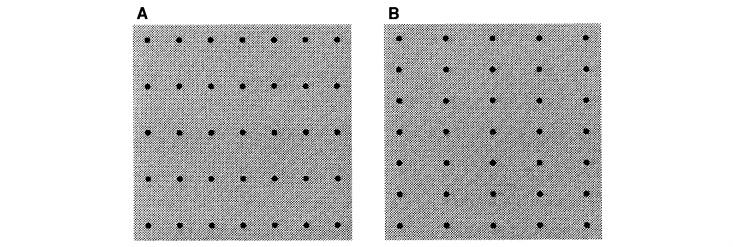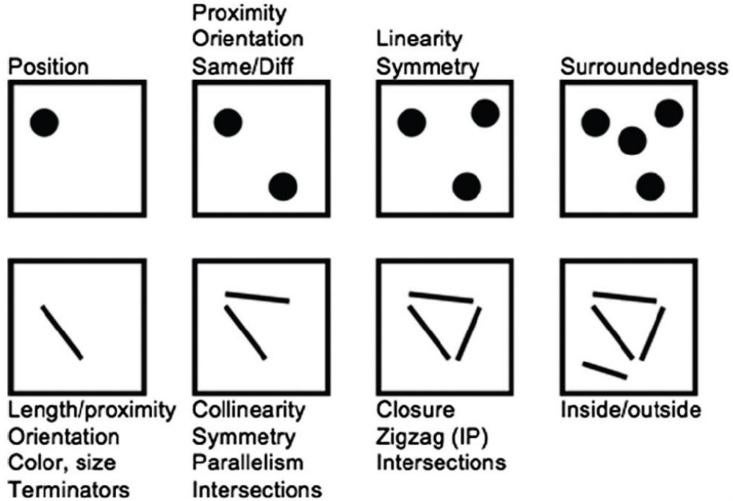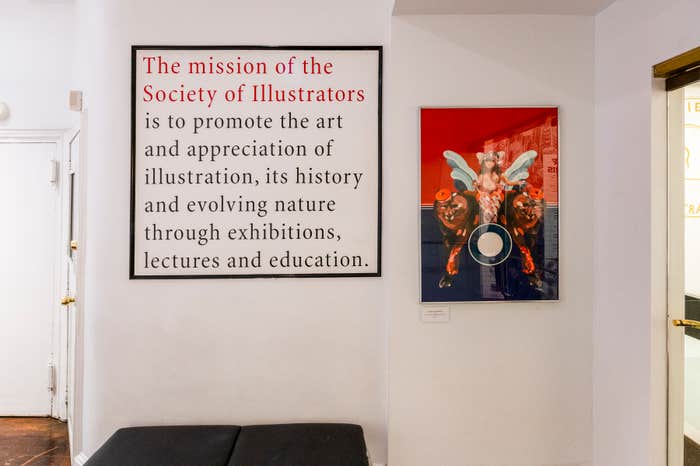For many thousands of years, and across cultures around the world, symmetry has been seen as beautiful. The mirror-image accuracy of the Parthenon is seen also in the Taj Mahal and the geometric patterns of traditional Navajo rugs. We see symmetry in more fluid, modern media, too, like the delicately mirrored shot composition of Wes Anderson and Stanley Kubrick films. We’re even more likely to perceive a face as beautiful (pdf) if it is more symmetric.
All of these are examples of bilateral symmetry—one half looks nearly identical to the other half. In a more general sense, symmetries are properties that remain invariant under some transformation; images with bilateral symmetry stay the same after reflectionacross a central line, for example. A recent synthesis of ideas from psychology suggests that symmetry, in this bigger sense, is not only aesthetically appealing but also important for how we visually make sense of the world.
These symmetries are rarely properties of individual components of an image; rather, they emerge from the interactions between all elements in the scene. It is the whole figure that matters. You can’t explain the beauty of the Taj Mahal by pointing to the curvature of one of its domes or the height of one of its towers. This was the central insight of the Gestalt (German for “shape”) school of psychology, which swept through Germany in the early 20th century and is now undergoing something of a modern rebirth. The Gestalt story about how symmetry powers our perception starts with a phenomenon called perceptual grouping.
When we look up at the night sky, we don’t just see a random scattering of dots: We see constellations, some of which trace back at least to ancient Egypt, and possibly further. Here’s the question of perceptual grouping: Given that there is no physical connection between most stars found in the same constellation, why do we perceive certain clumps that “go together” but not others? This organizational structure isn’t explicit in the raw visual input; it happens at a higher level of processing—in our heads, not our eyes.

In a seminal 1923 paper, German psychologist Max Wertheimer laid out basic principles the describe this “clumping” of our visual field. By manipulating the configuration of parts, the experimenter can change how the observer qualitatively interprets the whole. For example, in the lattice of dots on the left below, reproduced from a 1998 paper by Kubovy, Holcombe, and Wagemans (pdf), we naturally clump the dots into a set of horizontal lines (A). If we decrease the vertical distance until it’s less than the horizontal distance, however, we can change the global organization into a set of vertical lines (B).

This demonstrates the importance of proximity, which is not a property of any dot by itself—it only makes sense to talk about proximity when at least two elements are present. For this reason, proximity is called an emergent feature, as opposed to features of individual components like brightness or absolute location. Wertheimer and the other Gestalt psychologists called this foundational observation the law of proximity—in the absence of other cues, the perceptual system will group together items that are closer together. This phenomenon can also be seen in the example of Orion’s belt. The three stars in the belt (center of image) are closer to one another than other stars of equal brightness, hence we group them into a single unit.
Similar demonstrations led to an abundance of laws explaining grouping by different emergent properties: the law of similarity (objects that look similar), the law of continuity (objects that can be connected by a smooth curve as opposed to a jagged curve), the law of common fate (objects that move, or don’t move, together), and the law of symmetry (objects that form a bilaterallysymmetric image).
Around the Second World War, the Gestalt program began to lose steam. The researchers in the core Berlin group, many of whom had Jewish roots (like Wertheimer and Kurt Lewin) or were morally opposed to the Nazi regime (like Wolfgang Köhler), were scattered across America. There they lost prestige, conducted very few new experiments, and were unable to train new students. At the same time, more rigorous, quantitative methods were starting to dominate psychology, and it was difficult to see how Gestalt Laws could result from the increasingly influential reductionist accounts given by single-cell neuroscience1. From this more modern perspective, Gestalt research, based on people’s subjective, qualitative observations, appeared to be a weak form of evidence.
Re-emergence of the Psychology of Emergence
Decades after Wertheimer’s death in 1943, a new generation of researchers picked up the mantle of Gestalt perception and brought it back to relevance in the 21st century. Foremost among these researchers is Jim Pomerantz, a professor of psychology at Rice University, who built on the foundational work of the Gestalt school using the methods of modern experimental psychology. Using quantifiable measures like reaction times and accuracies, he could systematically investigate how emergent features (or “basic Gestalts”) arise from interactions between components.
Pomerantz designed an “odd-quadrant” task where the participant was instructed to look at a square containing one mark in each quadrant and press a button indicating which of the four quadrants was unlike the others, as quickly as they could. He then added a second element to each quadrant (the same element added to each quadrant this time) and had them repeat the task for this “composite” stimulus. At first, you might think that the composite test would be harder: There is more information, so it should take the brain longer to sift through it. If, however, we find faster speeds and higher accuracies in the composite case, then we have some evidence that an emergent feature appeared and supplied better information about than the individual parts. In other words, it suggests that our visual system is more attuned to emergent properties rather than to properties of the individual components. You can try the experiment yourself:

The composite test did turn out to be easier than the simpler version for certain stimuli, lending quantitative, objective data to the Gestalt hypothesis. (In the example above, the emergent features in the composite task include bilateral symmetry, parallelism, and closure, all of which are different in the odd quadrant: the lower-right one.) Using a series of these tasks, Pomerantz and graduate student Mary Portillo (now a professor of psychology at University of Houston—Downtown) extended this finding to discover that people are better at judging the distance or angle between dots than the location of either dot on its own; better at judging whether three dots fall in a line than judging the angle of any of the pairs on their own; and better at judging whether a pair of lines is parallel than judging the orientation of either line on its own.
His results suggest, at least for the small range of dot displays covered in the study, that there is a hierarchy of emergent visual features (pdf)—the higher we ascend, the more sensitive and powerful our perceptual systems become. If a higher-order feature in the hierarchy is available to us, we will use it3. In Orion’s Belt, which has three components, the dominating property is actually not proximity but linearity—the three component stars fall approximately in a line. Pomerantz’s hierarchy looks like this:

There are many details remaining to work out in Pomerantz’s theory, but it already shows promise for contributing to our ideas about human vision. Notice that depending on how we look at something, like a friend’s face, the image on our retina undergoes various transformations. When we move closer to our friend, their face appears to expand. When we tilt our head, theirs appears to rotate. It would be inefficient (and embarrassing) if we couldn’t recognize their face at some future meeting just because we were standing a little closer. It makes sense that our visual system focuses on properties that stay the same across different transformations—a sensitivity to symmetries.
Notice that every emergent feature in the hierarchy is symmetric under some transformations but not others: The proximity between someone’s eyes stays the same when you rotate your head, but not when you move closer or further from it. Orientation is the other way around. But higher-order features are even more stable. Pomerantz emphasizes two in particular: “If two lines are parallel, they will remain parallel in the retinal image over many transformations. The same is true for linearity.”
This discovery begins to answer the central mystery of the Gestalt psychologists: Why is our visual system more sensitive to some properties of a scene than others? Pomerantz’s work shows the existence of a hierarchy of important features, and the interpretation of those features as symmetries offers a potential reason why our visual system is more sensitive to some features than others: They’re more stable, hence, more useful. The next time you see a Wes Anderson film or an architectural masterpiece, take a moment to look away from the striking bilateral symmetry and marvel at all the subtler ways our visual system uses symmetry to maintain a stable perception of the world.
Footnotes
1. There’s much more to say about the rise and fall of Gestalt perception—for a deep, detailed history, see Ash’s 1998 book Gestalt psychology in German culture, 1890-1967: Holism and the quest for objectivity.
2. The evidence was weaker for bilateral symmetry and surroundedness, but this may be due to the conservative experimental design (the task sets a very high bar for finding an improvement in the composite condition) and authors concluded that they were still contenders.
Robert X.D. Hawkins is a PhD student in psychology at Stanford University.


























